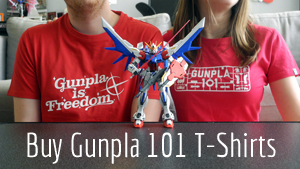
One of the most universal challenges of Gunpla building is dealing with nub marks: the whitish, raised chips of leftover sprue that can be left behind when you cut out a part. Gunpla 101 contributor Megaplamo, fresh from a stint judging competitive Gunpla, shares his surefire technique to do away with them once and for all:
Recently I was asked to judge a Gunpla competition. It was a great experience and I got to see some amazing work. One thing that I began to notice was that many of the kits, despite being painted really well, still had visible imperfections called nub marks.
Nub marks, also known as sprue marks, are one of the biggest distractors when it comes to the overall presentation of the kit. Many competitions have a scoring system that will take points away for nub marks. Even if you’re not building Gunpla for competition, nub marks make it difficult for the pieces to fit together properly, and in some cases create gaps between parts.
I wrote this article to go back to the basics and present my own nub removal process which is inspired by author and modeler Lincoln Wright’s process. Whether you’re looking to build Gunpla on the competitive level, or just want your kits to fit together more smoothly, this guide is designed to help you remove those pesky nub marks.
Gather Your Materials
First, let’s discuss tools. The best way to get Gunpla/model-making tools is from your local hobby shop. They can provide you with information, help solve problems and provide you with a community of other model makers. After the pandemic lockdown, I realized that community is the modelmaker’s greatest tool. Now that the lockdown has been lifted, I recommend visiting any of the following establishments (and complying with their masking rules, if in place):
- Comics shops
- HobbyTown
- Local game stores
- Local hobby shops
If you do not have a local hobby shop, there are a number of online stores that carry Gunpla tools and other model kits.
Things you will need:
- Regular nippers, such as Mr. Hobby Cutters or equivalent
- Side cutter nippers, such as God Hands or equivalent
- Sanding sponge or file set (600 – 800 grit)
Step 1: Remove the part from the sprue
When removing the part, be mindful to hold the sprue tree and not the piece so that the weight of the sprue tree does not bend or break the piece you are cutting out. This will also help with reducing stress marks.
See also: Everything I Wish I Knew About Stress Marks When I Started Building Gunpla
Step 2: Use regular sprue cutters to make the first cut
This is where your Mr. Hobby Cutters come into play. Make this cut closer to the sprue tree than the piece itself, leaving most of the nub behind for now.
Step 3: Remove the excess nub from the piece using the side cutters
Side cutters like God hands make a clean cut that can be made closer to the piece without causing damage. I prefer this to a hobby knife* for speed and accuracy.
*A note on hobby knives: Many people use hobby knives to cut the nub off in the second cut phase, however in my experience this can lead to injury and lead to damaging the part. I think a hobby knife is more appropriate for removing seam lines.
See also: How To Build Gunpla Without Cutting Yourself
Step 4: Sand away the excess nub.
Starting with a 400 grit sanding sponge or file, sand away what is left of the mark. Then polish with sequential grits (600, 800) until the piece has been returned to its original finish. Always start with your coarsest grit sandpaper and gradually use a finer one as you go.


Now, why would I tell you to go through so many types of sandpaper? After all, sanding might be the most boring thing in the world, next to watching paint dry. However, using a coarse grit and working your way down is actually faster than using one grit. I used to think, “Well if it needs to be 800 grit at the end, I will start there to save time.” But what ended up happening was that I actually ended up having to sand twice as much since the 800 grit is actually meant for finishing. This is like using a pair of scissors to cut your lawn. The stronger grit actually does the work of removing the nub mark and the sequential grits return the plastic to its original finish. This is a technique that I learned from Lincoln Wright.
If you do not plan to paint the kit, then you will want to sand away any plastic stress marks that create discoloration. If you do plan on painting, sand until the area of the nub mark is smooth.
There you have it: this is the process I use to remove nub marks. Use this as a guide to create your own process. The key is to balance accuracy with time-saving techniques so that you can build more kits and have more fun. Hopefully, this will help you in your model-making journey and you will get better results faster. Below is an HG Gabaldy Rebake I built as an example of what a good clean kit should look like when you follow these steps.
Megaplamo lives on the Gulf Coast of Alabama where he paints everything from Gunpla to vinyl garage kits. Megaplamo has been building model kits since the early 2000s and loves to share any and all information he has learned on his journey. You can find Megaplamo on all social media as @megaplamo although he is the most active on Instagram.















